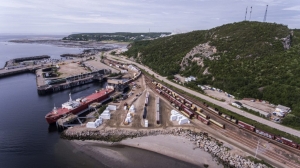


(Posted on 20/06/22)
The port of Rotterdam in the Netherlands and the Port of Baie Comeau in Canada have agreed to jointly explore the potential for future growth and development of the Port of Baie-Comeau.
The ports have agreed to execute a Master Plan Study including cargo flow analyses and technical port infrastructure assessments. The study will also include analysis for production and use potential of green energy in the industrial zone, such as wind and solar power, bioenergy and green hydrogen. The Port of Baie-Comeau and the port of Rotterdam intend to work in close co-operation with the City of Baie-Comeau, Government of Canada, Government of Quebec, the Pessamit First Nation community and other regional and commercial stakeholders.
The Société du Plan Nord is supporting this development plan by investing CAD $250,000. The amount awarded comes from the Opportunity envelope of the Government of Quebec's 2020-2023 Northern Action Plan.
Port of Rotterdam is a globally operating deep water seaport, with the capacity to handle the largest ships in the world, receiving 30.000 sea vessels per year. It stretches some 40-45 kilometres inland, has both the port and industrial zone under its care, with over 3.000 private companies working to handle large volumes of cargo and all logistics for these, for all types of trade, dry bulk, liquid bulk, containers, and break-bulk. It is the largest port of Europe and the number ten port of the world. Together with Houston and Singapore it is also known for its bunkering facilities for ships, and it is the Energy Gateway for Europe, with some 13% of all energy consumed in Europe entering Europe via Rotterdam and meeting some 40% of industrial demand. The port of Rotterdam is committed to the safety and efficiency of its port operations and has in recent years taken on a leading role in the Digitisation of ports. The Green Transition has been the most important strategic theme for the port in the past decade. The transition of the port to reduce carbon emissions and receive, handle and distribute the zero emission fuels and feedstocks of the future is in full swing now, with major infrastructure projects and many activities going on to meet climate targets, positioning the port of Rotterdam as one of the greenest ports in the world and as the Hydrogen hub for NW Europe.
The Canadian East-Coast deep-water port of Baie-Comeau recently changed ownership from Transport Canada to the Baie-Comeau Port Management Corporation. The port is situated in the Province of Québec, on the North Shore of the Saint Lawrence River, near the mouth of the Manicouagan River in the Baie des Anglais. It now has a large Cargill cereals terminal (the largest storage capacity for cereals in Canada) and an Alcoa aluminium smelter, powered for 99% with electricity from green sources. The port provides logistic services for the mining and the manufacturing industry of North-East Quebec and is connected to the national railroad network leading to the American Midwest aera and all major inland markets. Its aim as a port is to further increase its capacity to be an exporting hub for the manufactured products, natural resources, mining, cereals and green energy industry in the area, as well as developing port and industrial areas to attract new green industry clients to operate in the port. The Port currently works as an overflow port also for other ports and terminals in the region and is keen to work together with ports and terminals in the vicinity that are now working to their maximum capacity. The port has 24/7, 365 days per year availability of Operations if so required, as it does not freeze over in Winter. Quite recently, Ottawa and Quebec Governments allocated CAD 15 million (USD 11,9 million/EUR 10.9 million) to a feasibility study in Canada for the extension of the Dolbeau[1]Mistassini existing railway up to Baie-Comeau railway and maritime terminal.
The city of Baie-Comeau has a long-standing Industrial tradition and has always had an international outlook, with Paper Mills, Saw Mills, Aluminium mills and Power generation at the root of its original industrial activities in the 19th and 20th Century. Many workers came to Baie-Comeau from the US and various other parts of the world to settle in Baie-Comeau. Baie-Comeau is home to the Pessamit First nation community, as it is part of her traditional land called “Nitassinan”.
With this year’s Rail Conference “Rail Freight Transport and Seaports”, a joint initiative... Read more
Asian Bulk Logistics (ABL Group) and ICG have jointly announced the successful completion of ABL&rsquo... Read more
Abu Dhabi based AD Ports Group, a leading global enabler of integrated trade, industry and logistics... Read more
The Executive Board of Hamburger Hafen und Logistik AG (HHLA) has appointed Patrick Krawutschke as Managing... Read more
Abu Dhabi based AD Ports Group, a global enabler of integrated trade, transport, industry, and logistics... Read more
This year marks a significant milestone in maritime innovation as Port Hedland, Australia, celebrates... Read more
Associated British Ports (ABP), the UK’s leading port operator, has announced the latest tranche... Read more
During the Investment, Labour, and Trade Promotion Programme in Japan (November 16–22, 2025),... Read more
AD Ports Group subsidiary Khalifa Economic Zones Abu Dhabi - KEZAD Group, the largest operator of integrated... Read more
Abu Dhabi based AD Ports Group, a global enabler of integrated trade, transport, industry, and logistics... Read more